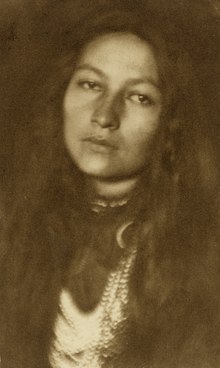Zitkala-Ša | |
|---|---|
 Zitkala-Ša in 1898, National Portrait Gallery, Smithsonian Institution | |
| Born | February 22, 1876 Yankton Indian Reservation, Dakota Territory |
| Died | January 26, 1938 (aged 61) Washington, DC, US |
| Resting place | Arlington National Cemetery |
| Other names | Gertrude Simmons Bonnin |
| Education | White's Manual Labor Institute, Wabash, Indiana |
| Alma mater | Earlham College |
| Occupations |
|
| Employer(s) | Carlisle Indian Industrial School, Bureau of Indian Affairs, Uintah-Ouray reservation |
| Known for | Co-composed the first American Indian opera, founded the National Council of American Indians, authored books and magazine articles |
| Notable work | Sun Dance Opera, Old Indian Legends, American Indian Stories, "Oklahoma's Poor Rich Indians" |
| Spouse | Raymond T. Bonnin |
| Children | Ohíya |
| Parent(s) | Mother, Ellen Simmons, also called Thaté Iyóhiwiŋ ("Every Wind" or "Reaches for the Wind") |
| Signature | |
Zitkala-Ša, also Zitkála-Šá (Lakota: Zitkála-Šá, meaning Red Bird;[1] February 22, 1876 – January 26, 1938), was a Yankton Dakota writer, editor, translator, musician, educator, and political activist. She was also known by her Anglicized and married name, Gertrude Simmons Bonnin. She wrote several works chronicling her struggles with cultural identity, and the pull between the majority culture in which she was educated, and the Dakota culture into which she was born and raised. Her later books were among the first works to bring traditional Native American stories to a widespread white English-speaking readership.
She was co-founder of the National Council of American Indians in 1926, which was established to lobby for Native people's right to United States citizenship and other civil rights they had long been denied. Zitkala-Ša served as the council's president until her death in 1938.[2] Zitkala-Ša has been noted as one of the most influential Native American activists of the 20th century. Working with American musician William F. Hanson, Zitkala-Ša wrote the libretto and songs for The Sun Dance Opera (1913), the first American Indian opera. It was composed in romantic musical style, and based on Sioux and Ute cultural themes.[3][4]